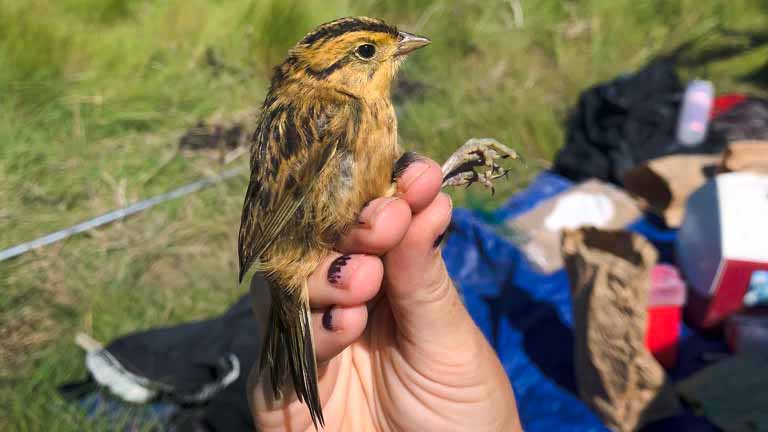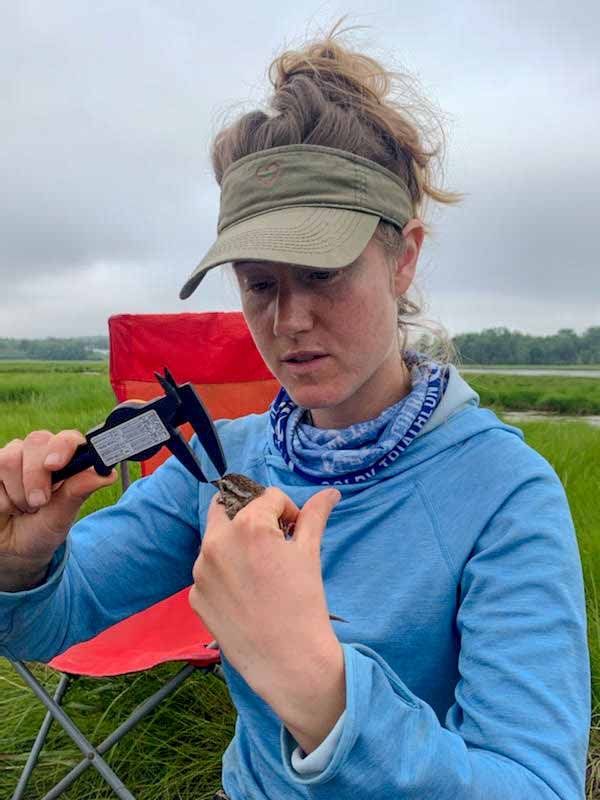
Exploring Feather Pigments and Tidal Marsh Sparrows with GECO Graduate Student Alice Hotopp
by Daniel Timmermann
Alice Hotopp is a graduate student working with the NSF EPSCoR funded GECO grant which seeks to better understand the interaction between genotypes, phenotypes, and an organism’s environment. Advised by Kristina Cammen (Assistant Professor, UMaine School of Marine Sciences) and Brian Olsen (Professor of Ornithology, UMaine School of Biology and Ecology), Hotopp is pursuing a PhD. in Ecology and Environmental Sciences.

After finishing her Master’s degree in Applied Ecology and Conservation Biology at Frostburg State University in Maryland, Hotopp joined GECO and began studying saltmarsh melanism, a pattern observed across several species of sparrows that have adapted to life in tidal saltmarshes. Hotopp explained that, “The feathers of tidal marsh sparrows are darker and greyer in color than the feathers of related sparrow species that live in freshwater environments. This pattern is also seen in other taxa such as mammals and reptiles that inhabit saltmarshes. Because saltmarsh melanism occurs across so many species, researchers think that it is an adaptation to an environmental challenge experienced by many organisms living in saltmarshes.”
It is hypothesized that melanin pigments can make feathers stronger and more resistant to degradation. Hotopp’s research centers on testing this hypothesis and the results will be particularly insightful to understanding how these birds endure their challenging environment.
“These birds live in a salty and tidally influenced environment. They literally nest in vegetation near the floor of the saltmarsh and then the saltmarsh floods each month with the Spring tide. They are so different from how their relatives live.” Hotopp explained, “The feathers are the primary site of interaction between an organism’s environment and its physical body. Things like the intense sun, salt, abrasive vegetation, and the microbial environment are all things the feathers are interacting with.” In her research, Hotopp will look for links between feather color and structure, the rate at which feathers degrade over the breeding season, and reproductive success, which could ultimately help explain the species’ ability to survive in their difficult saltmarsh environment.
When dealing with an imperiled species like these sparrows, designing methods and questions are difficult. “Not only are there a million ways to ask these questions. You also have to adapt all of those questions to a method that is going to work in the field, which is much different than doing research in a controlled lab setting.” Hotopp continued, “Then you have to do it safely with these birds whose populations are already declining rapidly.”
Hotopp’s field sites are based in Jonesport, Maine but Hotopp relies on data and samples collected from GECO sites scattered throughout Maine, New Hampshire, down all the way to New Jersey. Crews at each site work tirelessly throughout the field season studying bird populations and breeding success by tracking nests, and collecting phenotypic and genetic data. This work generates an incredible amount of data and thousands of feathers for Hotopp.
Using microscopy, Hotopp can measure variation in pigment distribution and feather structure across individuals and tidal marsh sparrow species. The data produced through this work combined with other phenotypic and genetic data generated by Hotopp and other researchers with GECO helps inform a deeper understanding of the sparrows, how they survive and how we could help them continue to survive in their challenging and changing environment.
